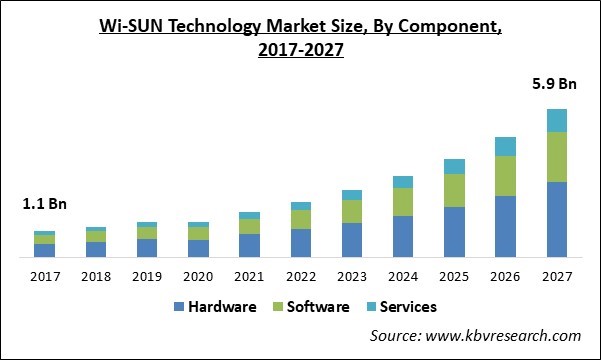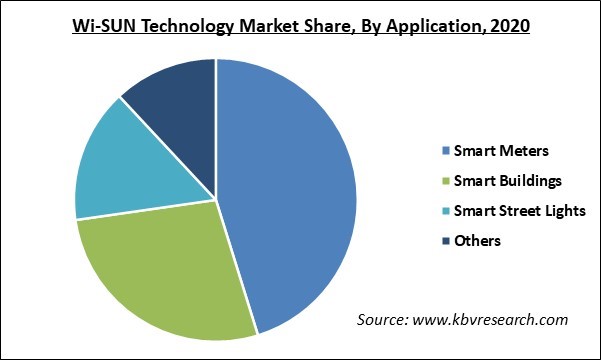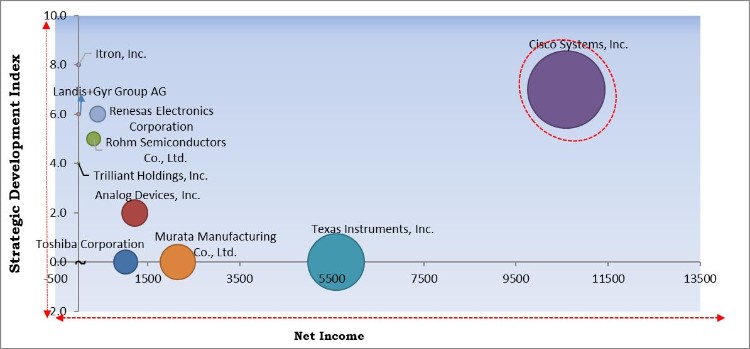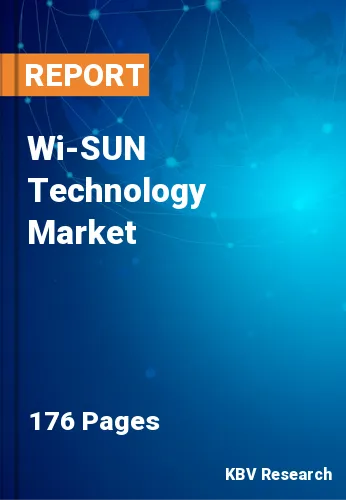The Global Wi-SUN Technology Market size is expected to reach $5,950.2 million by 2027, rising at a market growth of 21.7% CAGR during the forecast period.
Wi-SUN technology, which is the abbreviation of wireless smart utility network refers to a kind of wireless communication standard, which enables effortless connectivity among smart-grid devices. This Wi-Sun technology is based on numerous IEEE, IETF, and ANSI/TIA standards that reinforce the low power & loss networks.
Wi-SUN is also providing mesh-based field area networks (FAN) to deliver secure, resilient, and cost-effective connectivity with ubiquitous coverage in a variety of topographical surroundings, from densely populated urban areas to rural areas, with minimum additional infrastructure. For instance, Oklahoma Gas & Electric, a utility company is utilizing Wi-SUN technology to network of approx. 250,000 streetlights, at the same time, cities like Copenhagen, Glasgow, Bristol, Halifax, London and Paris have also embedded the network in various smart streetlight projects to expand their smart city infrastructure.
These standard helps in empowering large-scale outdoor IoT networks such as wireless mesh networks for Advanced Metering Infrastructure (AMI), distribution automation, home energy management, and some other large-scale outdoor network applications like HAN (Home Area Networks) and FAN (Field Area Networks).
Several technological advancements in hardware products like wireless modules, routers, sensors, and HEMS controllers & software solutions like sensor device software & gateway software, would contribute to the increasing popularity of WI-SUN technology in the world.

The outbreak of the COVID-19 pandemic has a significant impact on the Wi-SUN technology market due to the adoption of Wi-SUN technology solutions across different industries of the business domain. With the shifting lifestyle of the consumer and various disruptions in economic growth, the popularity of smart cities has also increased in the world. Therefore, the pandemic has substantially surged the demand for Wi-SUN technology across the world.
The investment of governments and municipalities in smart city initiatives is gradually increasing in the world, which is estimated to spur the growth of Wi-SUN technology in the post-COVID period. In addition, the adoption and penetration of Wi-SUN technology among enterprises and authorities have witnessed a surge across the globe during the COVID-19 pandemic.
Wi-SUN technology would become a feasible solution for the companies due to the consortiums being made with the help of numerous key technology providers. The increasing development of smart cities and smart infrastructure for removing communication costs with earlier standards like LPWA would contribute to the high demand for Wi-SUN technology in the upcoming years.
There is a rise in the utilization of various smart & connected devices like thermostats, smart meters, and other kinds of smart home appliances across the world, which would support the growth of the Wi-SUN technology market. Also, a rising inclination towards a sustainable way of living among consumers would create more demand for sustainable technology owing to the emergence of applications of IoT and its high adoption.
To integrate and connect smart meters, several utility companies are shifting from mesh technology like Wi-SUN with distributed access points to 4G and 5G cellular, which would restrict the demand and growth of the Wi-SUN technology market over the forecast period. In addition, the high efficiency and low cost of implementing advanced 4G and 5G cellular technology in smart meters would motivate companies to deploy them instead of Wi-SUN technology.

Based on component, the Wi-SUN technology market is divided into hardware, software, and services. The hardware segment dominated the Wi-SUN technology market in 2020 and is estimated to continue this trend over the forecast period. It is due to the fact that any organization cannot add further capabilities to interoperability using the Wi-SUN approach without upgrading their hardware components. Hence, hardware components play an important role in enhancing the operations and interoperability of the technology.
By application, the Wi-SUN technology market is segmented into smart meters, smart street lights, smart buildings, and others. The smart meters segment procured the highest share in the Wi-SUN technology market in 2020 and is estimated to continue this trend over the forecast period. The increasing adoption of smart meters to streamline a comprehensive range of applications in demand-side management, remote meter reading, customer relationship management, and value-added services is estimated to fuel the growth of the segment.
| Report Attribute | Details |
|---|---|
| Market size value in 2020 | USD 1.4 Billion |
| Market size forecast in 2027 | USD 5,950.2 million |
| Base Year | 2020 |
| Historical Period | 2017 to 2019 |
| Forecast Period | 2021 to 2027 |
| Revenue Growth Rate | CAGR of 21.7% from 2021 to 2027 |
| Number of Pages | 176 |
| Number of Tables | 273 |
| Report coverage | Market Trends, Revenue Estimation and Forecast, Segmentation Analysis, Regional and Country Breakdown, Competitive Landscape, Companies Strategic Developments, Company Profiling |
| Segments covered | Component, Application, Region |
| Country scope | US, Canada, Mexico, Germany, UK, France, Russia, Spain, Italy, China, Japan, India, South Korea, Singapore, Malaysia, Brazil, Argentina, UAE, Saudi Arabia, South Africa, Nigeria |
| Growth Drivers |
|
| Restraints |
|
Region-wise, the Wi-SUN technology market is analyzed across North America, Europe, Asia Pacific, and LAMEA. North America emerged as the leading region in the Wi-SUN technology market in 2020. This growth is attributed to the factors like the growing prevalence of Wi-SUN technology across this region. In addition, there are several factors like the presence of numerous leading device manufacturers & network service providers in the US, rising organization sizes, and growing applications of Wi-SUN technology, which would augment the growth of the regional market over the forecast period.
Free Valuable Insights: Global Wi-SUN Technology Market size to reach USD 5,950.2 million by 2027

The major strategies followed by the market participants are Partnerships. Based on the Analysis presented in the Cardinal matrix; Cisco Systems, Inc. is the major forerunners in the Wi-SUN Technology Market. Companies such as Toshiba Corporation, Analog Devices, Inc., Murata Manufacturing Co., Ltd. are some of the key innovators in the Market.
The market research report covers the analysis of key stake holders of the market. Key companies profiled in the report include Cisco Systems, Inc., Texas Instruments, Inc., Toshiba Corporation, Analog Devices, Inc., Renesas Electronics Corporation, Murata Manufacturing Co., Ltd., Itron, Inc., Landis+Gyr Group AG, Rohm Semiconductors Co., Ltd., and Trilliant Holdings, Inc.
By Component
By Application
By Geography
The Wi-SUN technology market size is projected to reach USD 5,950.2 million by 2027.
Increase in the number of smart cities are driving the market in coming years, however, availability of cost-effective 5G and 4G IoT connectivity for smart meters limited the growth of the market.
Cisco Systems, Inc., Texas Instruments, Inc., Toshiba Corporation, Analog Devices, Inc., Renesas Electronics Corporation, Murata Manufacturing Co., Ltd., Itron, Inc., Landis+Gyr Group AG, Rohm Semiconductors Co., Ltd., and Trilliant Holdings, Inc.
Yes, the investment of governments and municipalities in smart city initiatives is gradually increasing in the world, which is estimated to spur the growth of Wi-SUN technology in the post-COVID period.
The Services market is expected to witness highest CAGR of 23.3% during (2021 - 2027). Because the services segment includes various system integration services, maintenance & support services, and training & deployment services. These services enable end-users to enhance their productivity and functioning of various smart-grid devices.
The North America market dominated the Global Wi-SUN Technology Market by Region in 2020, and would continue to be a dominant market till 2027; thereby, achieving a market value of $2,068.9 Million by 2027.
Our team of dedicated experts can provide you with attractive expansion opportunities for your business.

